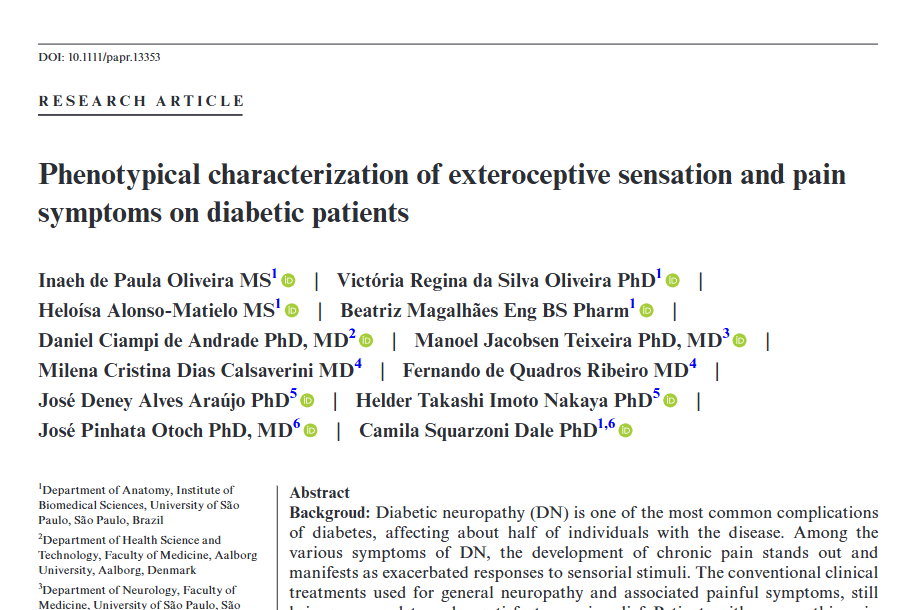Phenotypical characterization of exteroceptive sensation and pain symptoms on diabetic patients.
BACKGROUD: Diabetic neuropathy (DN) is one of the most common complications of diabetes, affecting about half of individuals with the disease. Among the various symptoms of DN, the development of chronic pain stands out and manifests as exacerbated responses to sensorial stimuli. The conventional clinical treatments used for general neuropathy and associated painful symptoms, still brings uncomplete and unsatisfactory pain relief. Patients with neuropathic pain syndromes are heterogeneous. They present with a variety of sensory symptoms and pain qualities which difficult the correct diagnosis of sensory comorbidities and consequently, the appropriate chronic pain management. AIMS: Herein, we aimed to demonstrate the existence of different sensory profiles on diabetic patients by investigating epidemiological and clinical data on the symptomatology of a group of patients with DN. METHODS: This is a longitudinal and observational study, with a sample of 57 volunteers diagnosed with diabetes from outpatient day clinic of Hospital Universitário of the University of São Paulo-Brazil. After being invited and signed the Informed Consent Form (ICF), patients were submitted to clinical evaluation and filled out pain and quality of life questionnaires. They also performed quantitative sensory test (QST) and underwent skin biopsy for correlation with cutaneous neuropathology. RESULTS: Data demonstrate that 70% of the studied sample presented some type of pain, manifesting in a neuropathic or nociceptive way, what has a negative impact on the life of patients with DM. We also demonstrated a positive association between pain and anxiety and depression, in addition to pain catastrophic thoughts. Three distinct profiles were identified in the sample, separated according to the symptoms of pain: (i) subjects without pain; (ii) with mild or moderate pain; (iii) subjects with severe pain. We also identified through skin biopsy that diabetic patients presented advanced sensory impairment, as a consequence of the degeneration of the myelinated and unmyelinated peripheral fibers. This study characterized the painful symptoms and exteroceptive sensation profile in these diabetic patients, associated to a considerable level of sensory degeneration, indicating, and reinforcing the importance of the long-term clinical monitoring of individuals diagnosed with DM, regarding their symptom profiles and exteroceptive sensitivity.
Authors
de Paula Oliveira I, da Silva Oliveira VR, Alonso-Matielo H
External link
Publication Year
Publication Journal
Associeted Project
Microbiology or Immunology
Lista de serviços
-
Gene regulatory and signaling networks exhibit distinct topological distributions of motifs.Gene regulatory and signaling networks exhibit distinct topological distributions of motifs.
-
Gene signatures of autopsy lungs from obese patients with COVID-19.Gene signatures of autopsy lungs from obese patients with COVID-19.
-
Network Medicine: Methods and ApplicationsNetwork Medicine: Methods and Applications
-
ACE2 Expression Is Increased in the Lungs of Patients With Comorbidities Associated With Severe COVID-19.ACE2 Expression Is Increased in the Lungs of Patients With Comorbidities Associated With Severe COVID-19.
-
Drug repositioning for psychiatric and neurological disorders through a network medicine approach.Drug repositioning for psychiatric and neurological disorders through a network medicine approach.
-
Linking proteomic alterations in schizophrenia hippocampus to NMDAr hypofunction in human neurons and oligodendrocytes.Linking proteomic alterations in schizophrenia hippocampus to NMDAr hypofunction in human neurons and oligodendrocytes.
-
In-depth analysis of laboratory parameters reveals the interplay between sex, age, and systemic inflammation in individuals with COVID-19.In-depth analysis of laboratory parameters reveals the interplay between sex, age, and systemic inflammation in individuals with COVID-19.
-
The evolution of knowledge on genes associated with human diseasesThe evolution of knowledge on genes associated with human diseases
-
Network vaccinology.Network vaccinology.
-
Pyruvate kinase M2 mediates IL-17 signaling in keratinocytes driving psoriatic skin inflammationPyruvate kinase M2 mediates IL-17 signaling in keratinocytes driving psoriatic skin inflammation
-
Transcriptome analysis of six tissues obtained post-mortem from sepsis patientsTranscriptome analysis of six tissues obtained post-mortem from sepsis patients
-
Gene Signatures of Symptomatic and Asymptomatic Clinical-Immunological Profiles of Human Infection by Leishmania (L.) chagasi in Amazonian BrazilGene Signatures of Symptomatic and Asymptomatic Clinical-Immunological Profiles of Human Infection by Leishmania (L.) chagasi in Amazonian Brazil
-
In vitro morphological profiling of T cells predicts clinical response to natalizumab therapy in patients with multiple sclerosis.In vitro morphological profiling of T cells predicts clinical response to natalizumab therapy in patients with multiple sclerosis.
-
Integrative immunology identified interferome signatures in uveitis and systemic disease-associated uveitis.Integrative immunology identified interferome signatures in uveitis and systemic disease-associated uveitis.
-
Gene regulatory networks analysis for the discovery of prognostic genes in gliomas.Gene regulatory networks analysis for the discovery of prognostic genes in gliomas.
-
Revealing shared molecular drivers of brain metastases from distinct primary tumors.Revealing shared molecular drivers of brain metastases from distinct primary tumors.

